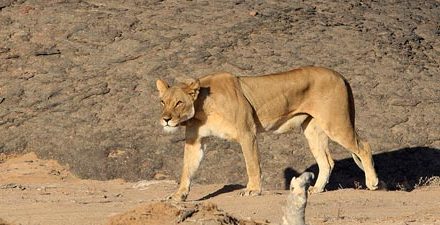
Understanding the dynamics of rabies in kudu populations

The FNB Foundation chairman, Claus Hinrichsen (left) presenting a symbolic kudu horn to the executive manager of the Namibia Agricultural Union, Sakkie Coetzee. FNB supports research to determine the extent, transfer, and arrest of rabies in kudus.
This is a vegetative defence mechanism and it prevents browsers, mostly kudus, from taking too much foliage from a single tree, or browsing too extensively in an isolated section of bush.
Much the same happened some years ago when Namibian researchers suspected rabies is now spread laterally through the kudu population without the assistance of a so-called vector, i.e. an infected agent, usually a mongoose, honey badger or jackal, that transfers the virus from one kudu to another.
This fact is borne out by field observation but it has not been proven to such an extent that it satisfies rigorous scientific scrutiny. Scientists suspect the the rabies virus spreads through a kudu population by direct infection through saliva in drinking water and on leaves, and when one animal grooms another.
However, to combat this disease is easier said than done. Efforts to develop a vaccine for administering through drinking water, are still in its infancy and much further research is required to determine the most effective methods, and the effectiveness of a suitable vaccine. Kudus are amazing wanderers, adding to the complexity of the problem to try and contain the spread of the virus. They are also very stubborn animals, they refuse to stand still to administer an oral vaccine.
This week, the FNB Namibia Foundation announced it has awarded a sponsorship of N$500,000 to the Namibian Agricultural Union (NAU) for their phase 1 Kudu Rabies research and vaccination project.
Dixon Norval, Head of Marketing and Communications at FNB Namibia said “The rate of infection remains unacceptably high and this is worrisome. Time might be running out if nothing is done. An urgent and effective control measure must be found and applied successfully for us to rescue this beautiful animal from extinction in our country.”
Dr. Rainer Hassel, the technical advisor for animal health at Agra said “The desired outcome for this project, besides controlling the alarming kudu rabies infection rate, is to gain more knowledge of the epidemic. Proving that transmission of the disease occurs through direct contact amongst infected kudus [is the first objective]. At the same time, [we are] working on a possible oral vaccine to administer to kudus. In phase one of the research and vaccination test trials, four animals will be placed in controlled captivity to administer different vaccines. This is a first attempt at trying to successfully implement a wild herbivore vaccine. If the vaccine is found to be successful it will further be tested with eight control groups. A possibility of inserting the vaccine in the kudus’ drinking water is also an option which the research team is investigating.”











































